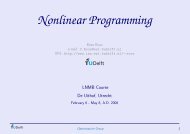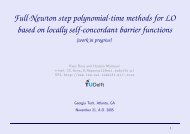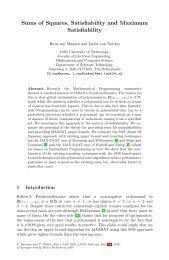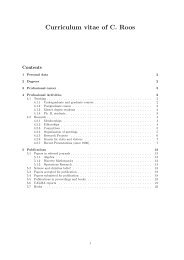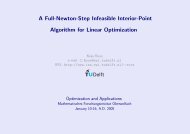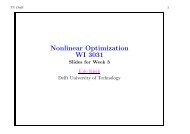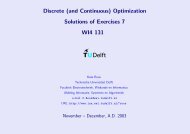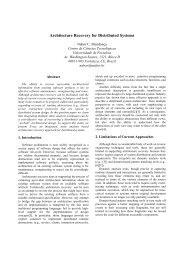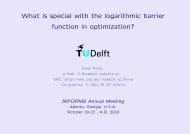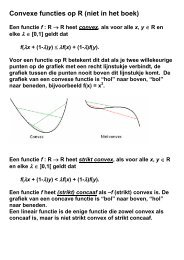On improving efficiency of model checking through systematically ...
On improving efficiency of model checking through systematically ...
On improving efficiency of model checking through systematically ...
Create successful ePaper yourself
Turn your PDF publications into a flip-book with our unique Google optimized e-Paper software.
nbac-like<br />
concrete <strong>model</strong><br />
Verification report<br />
NBAC<br />
(abstraction)<br />
PMC/UPPAAL<br />
(verification)<br />
nbac-like<br />
abstract <strong>model</strong><br />
nbac2pmc/nbac2uppaal<br />
(transformation)<br />
pmc/uppaal-like<br />
abstract <strong>model</strong><br />
1 2 3<br />
Figure 6.1: A systematic approach to combine Nbac and PMC/Uppaal<br />
part is necessary if we want to go further with complex systems. Anyhow,<br />
such a tool has not been developed yet at this moment.<br />
To enable PMC/Uppaal to verify abstract <strong>model</strong>s generated by Nbac, a<br />
transformation step is neccessary. This step is responsible for transforming<br />
an Nbac abstract <strong>model</strong> to an XTG <strong>model</strong>. Since the size <strong>of</strong> an Nbac abstract<br />
<strong>model</strong> is usually extremely large, this step must be done automatically by a<br />
computer program. We have developed such a tool for that purpose. Two<br />
versions <strong>of</strong> that tool are available: one for Nbac and PMC (nbac2xtgxml)and<br />
the other for Nbac and Uppaal (nbac2uppaal). We presented its design and<br />
implementation in Chapter 3.<br />
A few modifications have to be made when an Nbac abstract <strong>model</strong> is<br />
transformed to an XTG <strong>model</strong>. We firstly established a framework for the<br />
transformation and then implemented the tool following that transformation<br />
framework. The lack <strong>of</strong> some features in PMC made a resulting <strong>model</strong> too<br />
large for the reason that a number <strong>of</strong> elements have been added to the<br />
original <strong>model</strong> just to <strong>model</strong> missing features in PMC. However, it turned out<br />
that we still could not use PMC in our approach even after so much efforts<br />
had been made. Consequently, we decided to switch to Uppaal and thus the<br />
version nbac2xtgxml is obsolete now.<br />
After all components in our approach have been available, we are ready<br />
to evaluate the implementation <strong>of</strong> our approach. Four systems were picked<br />
up to use as case studies for our experiments including the tiny example, the<br />
asynchronous reader/writer algorithm (aka Burn’s algorithm), the Fischer’s<br />
protocol, and the subway system. As we described in details in Chapter<br />
4, these systems are very different from each others in original specified<br />
language, physical size, the characteristic <strong>of</strong> the state space and application<br />
area.<br />
The experimental results have shown that the tiny example and the<br />
58



